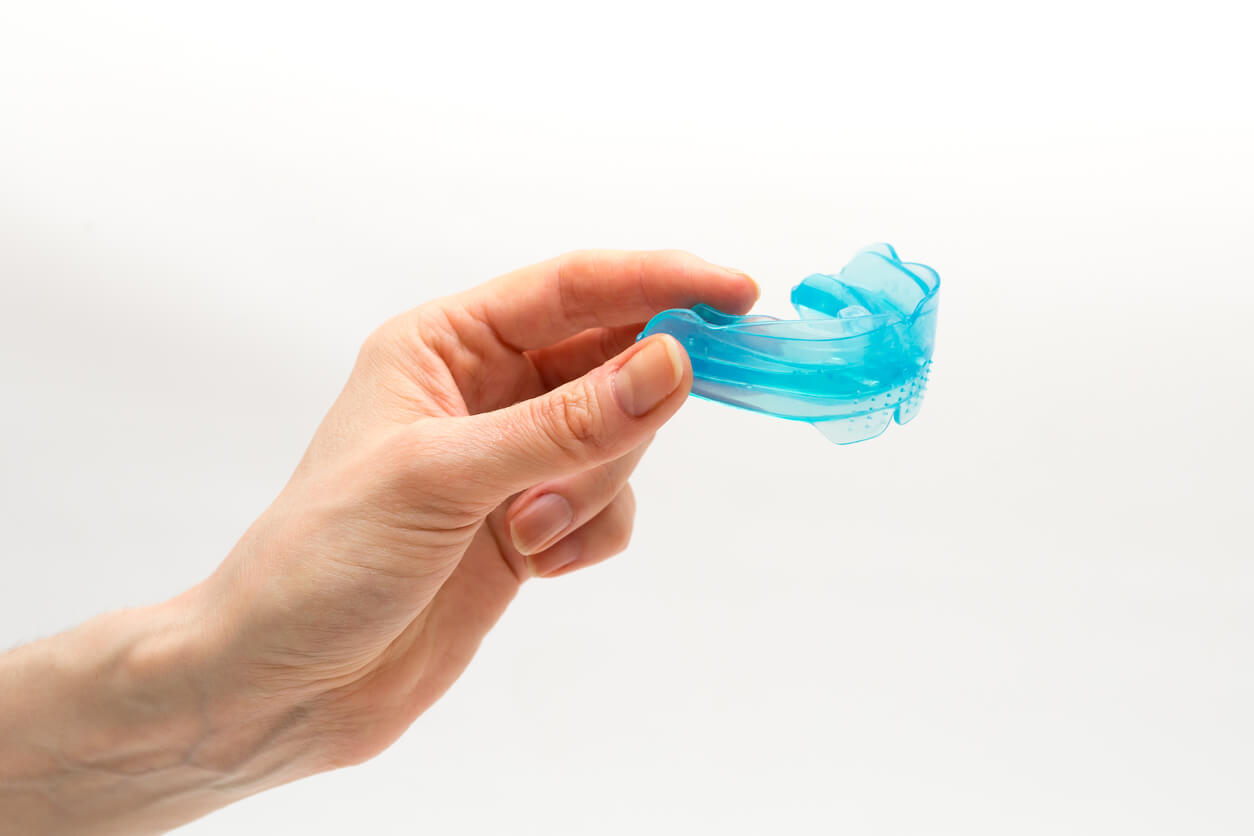What Is the Myobrace® System for Aligning Teeth?

When children have dysfunctional oral habits, the development of their mouth and face is affected. The Myobrace® system is an orthodontic option that is effective in aligning teeth from an early age.
Jaw malformations, malocclusions, or dental crowding are often due to childhood habits that prevent the correct development of the structures of the mouth. Correcting these harmful habits favors harmonious orofacial growth.
Keep reading to find out how it works, what its benefits are, and when it is recommended.
What’s the Myobrace® system for aligning teeth
The Myobrace® system is a preventive treatment that acts on the causes that lead to malocclusions. It’s used mainly during childhood to promote the correct growth of the jaws.
It consists of a series of removable appliances that are applied inside the mouth for 1 or 2 hours every day and then at night, while the child sleeps.
By using these appliances, it’s possible to correct harmful oral habits and exert light forces that stimulate the correct growth of the jaws. Using this type of procedure during infancy often avoids the need for braces or other more complex orthodontic treatments in the future.

What does the Myobrace® system do to align the teeth?
The Myobrace® system helps the bones to develop properly, improves the relationship between the arches, and allows the teeth to align in a natural way. The therapy seeks the balance of the orofacial musculature, molds the jaws, and corrects the functional problems that generate misalignments in the bite.
These are some of the purposes that are pursued when using this preventive orthodontic system:
- Correcting dysfunctional oral habits: With the Myobrace® system, children are taught to swallow properly, breathe through the nose, keep their lips together, and rest the tongue on the palate.
- Promoting the proper development of the jaws: The jaws are widened and stimulated. This helps the bones grow to their proper size.
- Aligning the teeth: The correct development of the jaws gives the teeth the space they need to position themselves naturally.
- Contributing to the harmonious development of the face.
- Improving the patient’s oral and overall health.
When is the Myobrace ® system for aligning teeth indicated?
The Myobrace ® system is useful to align the teeth of those children who present dysfunctional habits associated with malocclusions. The advantage of this technique is that it can be started as soon as the problem is diagnosed. In addition, if used before the age of 12, the results are more effective.
This type of appliance is indicated in cases of children with harmful habits that predispose them to malocclusions, such as the following:
- Mouth breathing
- Atypical swallowing
- Tongue thrusting
- Lip or finger suction
- Moderate bite problems and overbites
- Crowding and lack of space
Benefits of the Myobrace® system for aligning teeth
The Myobrace® system allows you to start treating bite problems from an early age. This early approach takes advantage of the bone growth stage and corrects harmful habits, favoring the correct development of the jaws.
In addition, this type of appliance has the following benefits:
- Speed: It’s possible to achieve great changes in a short time. Beginning to treat the problem before it has been installed accelerates the solution.
- Convenience: The splints are removable, which allows the child to remove them from their mouth to eat, talk, and clean themself normally.
- Hygiene: When the splints are removed, the child can sanitize them and at the same time brush, rinse, and floss as usual. This prevents the accumulation of bacterial plaque and maintains oral health.
- Aesthetics: The splints aren’t very visible and can go unnoticed when they’re being used. In addition, the child only wears them for a couple of hours a day.
- Low invasiveness: The simplicity of the splints avoids the discomfort caused by classic appliance systems, such as the accumulation of bacterial plaque, the risk of cavities, gingivitis, and mucosal lesions.
- Economical: The Myobrace® system provides an adequate cost-time-benefit ratio. Conventional appliances are expensive and take several years to achieve the expected results.
- Predictable results: Special technology is used to make the Myobrace® system splints, which makes it possible to foresee the changes that will occur in the child during treatment.

The stages of treatment with the Myobrace® system for aligning teeth
During treatment with the Myobrace® system, the child must wear an appliance every day for one or two hours during the day and all night while sleeping. The therapeutic process is divided into the following stages.
1. The correction of harmful habits
In this first stage, the patient is taught to exercise oral functions correctly in order to correct the harmful habits. For this, a flexible silicone appliance is used that adapts to the dental arch. The child learns to breathe through the nose instead of the mouth and to swallow properly. They also practice placing the tongue against the roof of the mouth when resting and keeping their lips together when they’re not eating or talking.
2. Dental arch development
Sometimes stimulating jaw development is necessary. If the dental arches can be widened, there will be enough space for the teeth and tongue to be properly positioned. To add this jaw growth stimulus during treatment, an extra structure is added to the silicone device.
3. Dental alignment
When the eruption of the definitive teeth is completed, it may be necessary to use the Myobrace® system to align the teeth. The aim is for the new elements to have a correct position in the arch and for the smile to be harmonious and functional.
Using the splints at this stage is essential to obtain the expected results. If there’s no commitment to the treatment or if the patient’s needs warrant it, the final alignment can be done using braces.
4. Retention
Retention is the final stage of treatment with Myobrace®. It seeks to maintain the results achieved and sustain good oral habits to avoid relapses. In this phase, firm retainers are used for a period of time.
The sooner, the better
The fact that children need orthodontics can produce anxiety or worries among parents. Delaying the intervention can aggravate the situation and cause irreversible damage to the mouth and face of little ones. By addressing bite problems early, better results are achieved and, at the same time, the procedures will be more comfortable and faster. Finally, don’t forget to take your child to a pediatric dentist on a regular basis. During regular check-ups, it’s possible to detect problems in the mouth and find the best solution for them.
All cited sources were thoroughly reviewed by our team to ensure their quality, reliability, currency, and validity. The bibliography of this article was considered reliable and of academic or scientific accuracy.
- da Cunha Busquet, P., de Jesus Portelinha, D., da Costa, M. L., & de Paula, V. D. A. C. (2021). How the myobrace appliance works: Advantages and disadvantages. Journal of Dental Problems and Solutions, 8(1), 019-023.
- Achmad, H., & Auliya, N. (2021). Management of Malocclusion in Children Using Myobrace Appliance: A Systematic Review. Annals of the Romanian Society for Cell Biology, 2120-2136.
- Kizi, G., Ventura, I., Barata, R., Ribas, D., & Castaño Sequeir, A. (2017, June). Early treatment of a class III malocclusion with the myobrace system: clinical case. In 2nd International Congress of CiiEM-Translational Research and Innovation in Human and Health Science.
- Ferreira, F. G. (2017). Novel Approaches for Class II Malocclusion Treatment using Myofunctional Orthodontics Therapy: A Systematic Review. Int. J. Dent. Oral. Sci, 4, 503-507.
- Anastasi, G., & Dinnella, A. (2014). Myobrace System: A no-braces approach to malocclusion and a myofunctional therapy device.
- Nery, S. S., de Araujo, P. X., Alves, M. J. M., de Araujo, E. X., & Sobreiro, M. A. F. (2022). Ortodontia Miofuncional-Sistema Myobrace® relato de caso clínico. Brazilian Journal of Health Review, 5(4), 12147-12161.
- Elnaili, S. A., Bushwigeer, S. S., & Alzway, A. A. (2019). Myobrace as an alternative to conventional orthodontics treatment.
